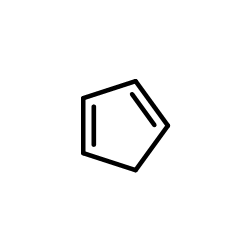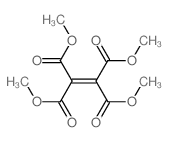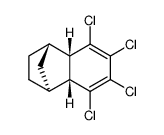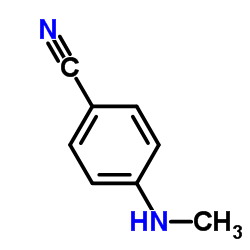498-66-8
| Name | norbornene |
|---|---|
| Synonyms |
2-Norbornene
norcamphene norborn-2-ene Norbornylene,stabilized EINECS 207-866-0 Bicyclo[2.2.1]hept-2-ene bicyclo[2.2.1]hept-5-ene norbornylene MFCD00082304 2-norbornylene bicyclo(2,2,1)hept-2Z-ene bicyclo(2.2.1)heptene Norbornene 3,6-Endomethylenecyclohexene Norfenchene |
| Density | 1.0±0.1 g/cm3 |
|---|---|
| Boiling Point | 96.0±0.0 °C at 760 mmHg |
| Melting Point | 44-46 °C(lit.) |
| Molecular Formula | C7H10 |
| Molecular Weight | 94.154 |
| Flash Point | -15.0±0.0 °C |
| Exact Mass | 94.078247 |
| LogP | 2.75 |
| Vapour Pressure | 50.7±0.1 mmHg at 25°C |
| Index of Refraction | 1.520 |
| Storage condition | 0-6°C |
Synonym:Bicyclo[2.2.1]-2-heptene; Norbornene; Norbornylene; Bicyclo[2.2.1]hept-2-ene Section 2 - COMPOSITION, INFORMATION ON INGREDIENTS
Risk Phrases: 11 Section 3 - HAZARDS IDENTIFICATION EMERGENCY OVERVIEW
Highly flammable.Extremely flammable. Potential Health Effects Eye: May cause eye irritation. Skin: May cause skin irritation. Ingestion: May cause irritation of the digestive tract. Inhalation: May cause respiratory tract irritation. May be harmful if inhaled. Chronic: No information found. Section 4 - FIRST AID MEASURES Eyes: In case of contact, immediately flush eyes with plenty of water for at least 15 minutes. Get medical aid. Skin: In case of contact, flush skin with plenty of water. Remove contaminated clothing and shoes. Get medical aid if irritation develops and persists. Wash clothing before reuse. Ingestion: If swallowed, do not induce vomiting unless directed to do so by medical personnel. Never give anything by mouth to an unconscious person. Get medical aid. Inhalation: If inhaled, remove to fresh air. If not breathing, give artificial respiration. If breathing is difficult, give oxygen. Get medical aid. Notes to Physician: Treat symptomatically and supportively. Section 5 - FIRE FIGHTING MEASURES General Information: As in any fire, wear a self-contained breathing apparatus in pressure-demand, MSHA/NIOSH (approved or equivalent), and full protective gear. Vapors can travel to a source of ignition and flash back. Flammable solid. Extinguishing Media: Use water spray, dry chemical, carbon dioxide, or chemical foam. Section 6 - ACCIDENTAL RELEASE MEASURES General Information: Use proper personal protective equipment as indicated in Section 8. Spills/Leaks: Vacuum or sweep up material and place into a suitable disposal container. Remove all sources of ignition. Provide ventilation. Use only non-sparking tools and equipment. Section 7 - HANDLING and STORAGE Handling: Use spark-proof tools and explosion proof equipment. Avoid breathing dust, vapor, mist, or gas. Avoid contact with eyes, skin, and clothing. Take precautionary measures against static discharges. Use only with adequate ventilation. Keep away from heat, sparks and flame. Storage: Keep away from sources of ignition. Store in a tightly closed container. Refrigerator/flammables. Section 8 - EXPOSURE CONTROLS, PERSONAL PROTECTION Engineering Controls: Facilities storing or utilizing this material should be equipped with an eyewash facility and a safety shower. Use adequate ventilation to keep airborne concentrations low. Exposure Limits CAS# 498-66-8: Russia: 3 mg/m3 TWA Personal Protective Equipment Eyes: Wear chemical splash goggles. Skin: Wear appropriate protective gloves to prevent skin exposure. Clothing: Wear a chemical apron. Respirators: Follow the OSHA respirator regulations found in 29 CFR 1910.134 or European Standard EN 149. Use a NIOSH/MSHA or European Standard EN 149 approved respirator if exposure limits are exceeded or if irritation or other symptoms are experienced. Section 9 - PHYSICAL AND CHEMICAL PROPERTIES Physical State: Solid Color: white Odor: pungent sour pH: Not available. Vapor Pressure: 39.2 mm Hg @ 25 deg C Viscosity: Not available. Boiling Point: 96 deg C @ 760 mm Hg Freezing/Melting Point: 42 - 46 deg C Autoignition Temperature: Not available. Flash Point: -15 deg C ( 5.00 deg F) Explosion Limits, lower: Not available. Explosion Limits, upper: Not available. Decomposition Temperature: Solubility in water: practically insoluble Specific Gravity/Density: Molecular Formula: C7H10 Molecular Weight: 94.15 Section 10 - STABILITY AND REACTIVITY Chemical Stability: No information found. Conditions to Avoid: High temperatures, ignition sources, confined spaces. Incompatibilities with Other Materials: Strong oxidizing agents, strong acids. Hazardous Decomposition Products: Carbon monoxide, carbon dioxide. Hazardous Polymerization: May occur. Section 11 - TOXICOLOGICAL INFORMATION RTECS#: CAS# 498-66-8: RB7900000 LD50/LC50: CAS# 498-66-8: Oral, mouse: LD50 = 13000 mg/kg; Oral, rat: LD50 = 11300 mg/kg; Skin, rabbit: LD50 = >5 mL/kg. Carcinogenicity: Norbornylene - Not listed by ACGIH, IARC, or NTP. Other: See actual entry in RTECS for complete information. Section 12 - ECOLOGICAL INFORMATION Section 13 - DISPOSAL CONSIDERATIONS Dispose of in a manner consistent with federal, state, and local regulations. Section 14 - TRANSPORT INFORMATION IATA Shipping Name: FLAMMABLE SOLID, ORGANIC, N.O.S.* Hazard Class: 4.1 UN Number: 1325 Packing Group: II IMO Shipping Name: FLAMMABLE SOLID, ORGANIC, N.O.S. Hazard Class: 4.1 UN Number: 1325 Packing Group: II RID/ADR Shipping Name: FLAMMABLE SOLID, ORGANIC, N.O.S. Hazard Class: 4.1 UN Number: 1325 Packing group: II Section 15 - REGULATORY INFORMATION European/International Regulations European Labeling in Accordance with EC Directives Hazard Symbols: F Risk Phrases: R 11 Highly flammable. Safety Phrases: S 9 Keep container in a well-ventilated place. S 16 Keep away from sources of ignition - No smoking. S 33 Take precautionary measures against static discharges. WGK (Water Danger/Protection) CAS# 498-66-8: No information available. Canada CAS# 498-66-8 is listed on Canada's NDSL List. CAS# 498-66-8 is not listed on Canada's Ingredient Disclosure List. US FEDERAL TSCA CAS# 498-66-8 is listed on the TSCA inventory. SECTION 16 - ADDITIONAL INFORMATION N/A |
CHEMICAL IDENTIFICATION
HEALTH HAZARD DATAACUTE TOXICITY DATA
|
| Symbol |



GHS02, GHS07, GHS09 |
|---|---|
| Signal Word | Danger |
| Hazard Statements | H228-H319-H411 |
| Precautionary Statements | P210-P273-P305 + P351 + P338 |
| Personal Protective Equipment | Eyeshields;full-face particle respirator type N100 (US);Gloves;respirator cartridge type N100 (US);type P1 (EN143) respirator filter;type P3 (EN 143) respirator cartridges |
| Hazard Codes | F:Highlyflammable; |
| Risk Phrases | R11 |
| Safety Phrases | S9-S16-S29-S33 |
| RIDADR | UN 1325 4.1/PG 2 |
| WGK Germany | 1 |
| RTECS | RB7900000 |
| Packaging Group | II |
| Hazard Class | 4.1 |
| Precursor 9 | |
|---|---|
| DownStream 10 | |

![5-(phenylsulfonyl)bicyclo[2.2.1]hept-2-ene structure](https://image.chemsrc.com/caspic/454/794592-27-1.png)


![Tricyclo[5.2.1.02,6]deca-3,8-diene structure](https://image.chemsrc.com/caspic/118/77-73-6.png)


![3-iodobicyclo[2.2.1]heptane structure](https://image.chemsrc.com/caspic/230/30983-85-8.png)


![diexo-3-Amino-bicyclo[2.2.1]heptane-2-carboxylic acid ethyl ester structure](https://image.chemsrc.com/caspic/267/105786-35-4.png)
![Bicyclo[2.2.1]heptane-2-carboxamide, 3-amino-, (1R,2S,3R,4S)-rel- (9CI) structure](https://image.chemsrc.com/caspic/115/105786-39-8.png)


![3-Chlorobicyclo[3.2.1]oct-2-ene structure](https://image.chemsrc.com/caspic/350/35242-17-2.png)



![3-oxatricyclo[3.2.1.02,4]octane structure](https://image.chemsrc.com/caspic/054/278-74-0.png)
